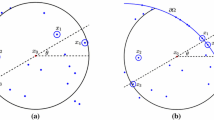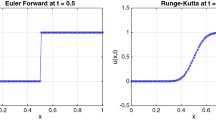Abstract
In this paper, we propose a unified framework, the Hessian discretisation method (HDM), which is based on four discrete elements (called altogether a Hessian discretisation) and a few intrinsic indicators of accuracy, independent of the considered model. An error estimate is obtained, using only these intrinsic indicators, when the HDM framework is applied to linear fourth order problems. It is shown that HDM encompasses a large number of numerical methods for fourth order elliptic problems: finite element methods (conforming and non-conforming) as well as finite volume methods. We also use the HDM to design a novel method, based on conforming \(\mathbb {P}_1\) finite element space and gradient recovery operators. Results of numerical experiments are presented for this novel scheme and for a finite volume scheme.

Similar content being viewed by others
References
Balasundaram, S., Bhattacharyya, P.K.: A mixed finite element method for fourth order elliptic equations with variable coefficients. Comput. Math. Appl. 10(3), 245–256 (1984)
Bhattacharyya, P.K.: Mixed finite element methods for fourth order elliptic problems with variable coefficients. In: Brebbia, C.A. (ed.) Variational Methods in Engineering (Southampton, 1985), pp. 2.3–2.12. Springer, Berlin (1985)
Brenner, S., Scott, L.: The Mathematical Theory of Finite Element Methods. Springer, New York (1994)
Chen, H., Guo, H., Zhang, Z., Zou, Q.: A \({C}^0\) linear finite element method for two fourth-order eigenvalue problems. IMA J. Numer. Anal. (2016). https://doi.org/10.1093/imanum/drw051
Chen, J., Wang, D., Du, Q.: Linear finite element super-convergence on simplicial meshes. Math. Comput. 83, 2161–2185 (2014)
Ciarlet, P.G.: The Finite Element Method for Elliptic Problems. Elsevier, New York (1978)
Di Pietro, D.A., Ern, A.: Mathematical Aspects of Discontinuous Galerkin Methods. Mathématiques and Applications (Berlin) [Mathematics and Applications], vol. 69. Springer, Heidelberg (2012)
Douglas Jr., J., Dupont, T., Percell, P., Scott, R.: A family of \(C^{1}\) finite elements with optimal approximation properties for various Galerkin methods for 2nd and 4th order problems. RAIRO Anal. Numér. 13(3), 227–255 (1979)
Droniou, J., Eymard, R.: The asymmetric gradient discretisation method. In: Finite Volumes for Complex Applications VIII—Methods and Theoretical Aspects, volume 199 of Springer Proceedings of Mathematics and Statistics, pp. 311–319. Springer, Cham (2017)
Droniou, J., Eymard, R., Gallouët, T., Guichard, C., Herbin, R.: The Gradient Discretisation Method, Mathematics and Applications, 82. Springer, Berlin (2018). https://hal.archives-ouvertes.fr/hal-01382358
Eymard, R., Gallouët, T., Herbin, R.: Finite volume methods. In: Ciarlet, P.G., Lions, J.-L. (eds.) Techniques of Scientific Computing. Part III, Handbook of Numerical Analysis, VII, pp. 713–1020. North-Holland, Amsterdam (2000)
Eymard, R., Gallouët, T., Herbin, R., Linke, A.: Finite volume schemes for the biharmonic problem on general meshes. Math. Comput. 81(280), 2019–2048 (2012)
Eymard, R., Herbin, R.: Approximation of the biharmonic problem using piecewise linear finite elements. C. R. Math. Acad. Sci. Paris 348(23–24), 1283–1286 (2010)
Falk, R.S.: Approximation of the biharmonic equation by a mixed finite element method. SIAM J. Numer. Anal. 15(3), 556–567 (1978)
Herbin, R., Hubert, F.: Benchmark on discretization schemes for anisotropic diffusion problems on general grids. In: Eymard, R. (ed.) Finite Volumes for Complex Applications V, pp. 659–692. ISTE, London (2008)
Kim, C., Lazarov, R., Pasciak, J., Vassilevski, P.: Multiplier spaces for the mortar finite element method in three dimensions. SIAM J. Numer. Anal. 39, 519–538 (2001)
Lamichhane, B.: Higher Order Mortar Finite Elements with Dual Lagrange Multiplier Spaces and Applications. Ph.D. thesis, Universität Stuttgart (2006)
Lamichhane, B.: A stabilized mixed finite element method for the biharmonic equation based on biorthogonal systems. J. Comput. Appl. Math. 235, 5188–5197 (2011)
Lamichhane, B., Stevenson, R., Wohlmuth, B.: Higher order mortar finite element methods in 3D with dual Lagrange multiplier bases. Numer. Math. 102, 93–121 (2005)
Lamichhane, B.P.: A stabilized mixed finite element method for the biharmonic equation based on biorthogonal systems. J. Comput. Appl. Math. 235(17), 5188–5197 (2011)
Lamichhane, B.P.: A finite element method for a biharmonic equation based on gradient recovery operators. BIT 54(2), 469–484 (2014)
Lascaux, P., Lesaint, P.: Some nonconforming finite elements for the plate bending problem. Rev. Fr. Autom. Inform. Rech. Oper. Rouge Anal. Numér. 9(R–1), 9–53 (1975)
Li, J.: Full-order convergence of a mixed finite element method for fourth-order elliptic equations. J. Math. Anal. Appl. 230(2), 329–349 (1999)
Li, Y., An, R., Li, K.: Some optimal error estimates of biharmonic problem using conforming finite element. Appl. Math. Comput. 194(2), 298–308 (2007)
Nataraj, N., Bhattacharyya, P.K., Balasundaram, S., Gopalsamy, S.: On a mixed-hybrid finite element method for anisotropic plate bending problems. Int. J. Numer. Methods Eng. 39(23), 4063–4089 (1996)
Percell, P.: On cubic and quartic Clough–Tocher finite elements. SIAM J. Numer. Anal. 13(1), 100–103 (1976)
Powell, M.J.D., Sabin, M.A.: Piecewise quadratic approximations on triangles. ACM Trans. Math. Softw. 3(4), 316–325 (1977)
Scapolla, T.: A mixed finite element method for the biharmonic problem. RAIRO Anal. Numér. 14(1), 55–79 (1980)
Xie, Z.H.: Error estimate of nonconforming finite element approximation for a fourth order elliptic variational inequality. Northeast. Math. J. 8(3), 329–336 (1992)
Xu, J., Zhang, Z.: Analysis of recovery type a posteriori error estimators for mildly structured grids. Math. Comput. 73, 1139–1152 (2004)
Author information
Authors and Affiliations
Corresponding author
Appendix: Technical Results
Appendix: Technical Results
Lemma A.1
(Poincaré inequality along an edge) Let \({\sigma }\) be an edge of a polygonal cell, \(w \in H^1({\sigma })\) and assume that w vanish at a point on the edge \({\sigma }\in {\mathcal F}\). Then there exists \( C > 0 \) such that
where \(\partial \) denotes the derivative along the edge and \(h_{\sigma }\) is the length of the edge.
Proof
Let m denote the point on the edge \({\sigma }\) which satisfies \(w(m) = 0\). For \(m < x\), we get
A use of Cauchy–Schwarz inequality yields
Squaring this yields \(|w(x)|^2\le h_{\sigma }\int _{\sigma }|\partial w|^2{\,\mathrm d}y\) and integrating over the edge concludes the proof. \(\square \)
Lemma A.2
(Integration by parts) Let P be a fourth order tensor. For \(\xi \in H^2({\Omega })^{d \times d}\) and \(\phi \in H^1(\Omega )\), we have
For \(\psi \in H^2(\Omega )\),
For \(\zeta \in H^1(\Omega )^d\),
Rights and permissions
About this article
Cite this article
Droniou, J., Lamichhane, B.P. & Shylaja, D. The Hessian Discretisation Method for Fourth Order Linear Elliptic Equations. J Sci Comput 78, 1405–1437 (2019). https://doi.org/10.1007/s10915-018-0814-7
Received:
Revised:
Accepted:
Published:
Issue Date:
DOI: https://doi.org/10.1007/s10915-018-0814-7




